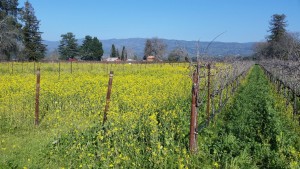We’re often asked “What time of year is best to visit Napa and Sonoma?”. We always answer that it doesn’t matter, that there are pluses and minuses whatever time of year you go there. With this issue, Power Tasting initiates an occasional series that will try to capture the essence of each of month of the year in California’s foremost wine making regions. It’s still a good idea to go whenever your calendar allows, but some months might fit your tastes better than others.
One way in which Napa Valley and Sonoma County are alike is the weather. It’s not going to rain on one side of the mountain and be sunny on the other. And in both regions, all year long, you are likely to observe the same strange weather phenomenon: no matter the season, days begin cold, humid and grey. Then at mid-morning, in a period of 15 minutes or so, the clouds part, the sun comes out and you spend the rest of the day under glorious blue skies.
However, in January you run a fair chance of it being grey and rainy for the entire day. 2017 had a historically wet winter, complete with some significant flooding in certain areas, especially Russian River. [“Russian River rises again, flooding Guerneville”, http://www.sfgate.com/bayarea/article/Russian-River-Guerneville-flooding-rise-level-10917521.php#photo-12167050 gives an especially good look at what it was like.] There’s nothing like a flood to spoil an otherwise pleasant day of wine tasting. But even in the notorious drought years, you could still get a lousy day in Wine Country in January.
Floods aside, there is some benefit to wine tasting on a rainy January day: There aren’t as many people there. The tasting rooms aren’t as crowded; you can get a table at the best restaurants; and the hotels lower their prices. Your odds are good, especially on a weekday, but it can still be very crowded at times. Mid-January brings the Martin Luther King holiday weekend and those wanting a last blast of Christmas and New Year’s come out in droves. We were shocked on several occasions to find normally sedate wineries packed with people who were obviously more interested in imbibing than tasting.
One of the glories of visiting these regions, especially Napa Valley, is the outburst of color known as Mustard Season. At this time, wild mustard naturally blooms in the fields and many grape growers let it stay. We once thought it enhanced the soil but we later learned that farmers like pretty views just as much as visitors do, so it’s an esthetic decision on their part, not an agricultural one. To our memories, Mustard Season used to occur more in the February-March time of year, but it is coming earlier now. Maybe it’s global warming or the heavy rains, but it’s happening earlier now and lasting longer.
Photo taken on January 16, 2017
As can be seen in the photo, there are plenty of bright, sunny January days in between the showers. It may be a little colder than some would like for wine tasting (that would be Steve) but you don’t get the searing hot afternoons that others detest (that would be Lucie). Generally, a sweater, light jacket or down vest is appropriate for the January temperatures in Napa/Noma. And you almost never get any snow.
Because the vines are bare in January, it’s best not to plan visits to wineries where one of the main attractions is the view across the vineyards. You may still want to taste the wines at, say, Stag’s Leap in Napa or Rochioli in Russian River but you will lose an important part of the wine tasting experience. If your trip in January is the only time you will be in Napa/Noma for a long while, definitely visit wineries such as these, but put your imagination in overdrive to get an idea of what it’s like in high summer.
